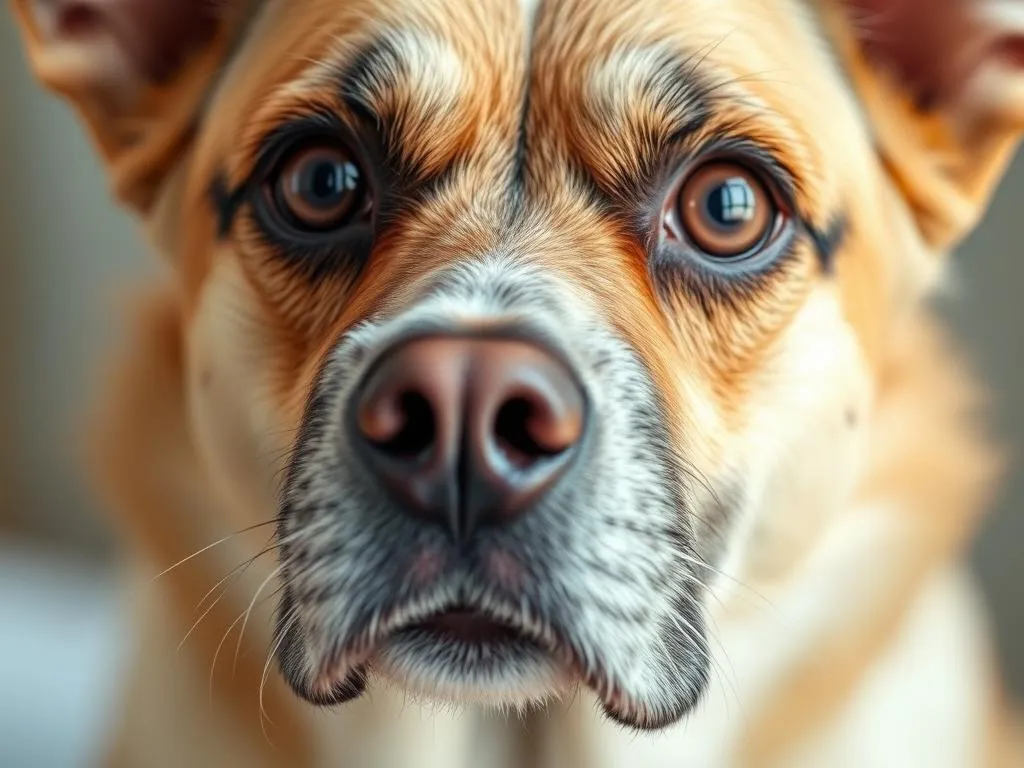
Maintaining your dog’s eye health is crucial for their overall well-being. Just like humans, dogs can suffer from a variety of eye diseases that can affect their vision and quality of life. Statistics show that approximately 20% of dogs will experience some form of eye disease in their lifetime, making it essential for dog owners to be informed about potential issues.
Understanding Canine Eye Anatomy
Basic Structure of a Dog’s Eye
To appreciate the various eye diseases in dogs, it’s important to understand the basic structure of a dog’s eye. A dog’s eye consists of several key components:
- Cornea: The clear front surface that helps focus light.
- Lens: Located behind the cornea, it further focuses light onto the retina.
- Retina: The light-sensitive layer at the back of the eye that converts light into signals sent to the brain.
- Iris: The colored part of the eye that controls the amount of light entering.
Unique Features of Dog Eyes
Dogs have unique features that distinguish their eyes from humans. For example, dogs have a wider field of vision (approximately 240 degrees compared to the human 180 degrees) and possess a layer of cells called the tapetum lucidum that enhances their night vision. These differences play a critical role in how dogs perceive the world and can influence their susceptibility to certain eye diseases.
Common Eye Diseases in Dogs
Cataracts
Cataracts occur when the lens of the eye becomes cloudy, affecting the dog’s vision.
- Causes: Genetics, diabetes, and aging are primary contributors.
- Symptoms: Look for signs such as cloudiness in the eye, difficulty seeing at night, or changes in behavior like bumping into objects.
- Treatment Options: Surgical removal of the cataract is the most effective treatment, restoring vision in many cases.
Glaucoma
Glaucoma is a serious condition characterized by increased pressure in the eye.
- Explanation: This pressure can damage the optic nerve, leading to pain and potential blindness.
- Signs and Symptoms: Watch for redness, excessive tearing, squinting, or a visibly enlarged eye.
- Potential Treatments: Medications to reduce intraocular pressure and, in severe cases, surgical intervention may be necessary.
Dry Eye (Keratoconjunctivitis Sicca)
Dry eye occurs when a dog doesn’t produce enough tears, leading to discomfort and potential damage to the eye.
- What it is: Often caused by autoimmune diseases or certain breeds being predisposed to the condition.
- Symptoms: Look out for redness, discharge, and excessive blinking.
- Treatment Approaches: Lifelong management often includes artificial tears and medications to stimulate tear production.
Progressive Retinal Atrophy (PRA)
PRA is a degenerative eye disease that affects the retina, leading to vision loss.
- Overview: This hereditary condition causes progressive vision loss, starting with night blindness and leading to complete blindness.
- Symptoms: Owners may notice their dog struggling in low light or bumping into objects.
- Current Treatment Options: There is no cure, but management strategies include maintaining a safe environment and regular veterinary check-ups.
Cherry Eye
Cherry eye is a condition where the tear gland in the dog’s third eyelid protrudes, creating a noticeable red mass.
- Explanation: This gland can become displaced due to genetics or chronic irritation.
- Symptoms: The most obvious sign is the visible red lump in the eye corner.
- Surgical and Non-Surgical Treatments: Surgery is often required to reposition the gland, though some cases may be managed with medication.
Recognizing Symptoms of Eye Diseases
Common Signs of Eye Problems
Being vigilant about your dog’s eye health can help in early diagnosis. Here are some symptoms to watch for:
- Redness and Discharge: Abnormal redness or discharge can indicate infection or irritation.
- Squinting and Excessive Blinking: This may suggest discomfort or pain.
- Behavioral Changes: Hesitation to play or difficulty navigating familiar environments can signal vision issues.
When to Seek Veterinary Care
If you notice any of the above symptoms in your dog, it’s essential to consult your veterinarian. Early detection of eye diseases in dogs can significantly improve treatment outcomes. It’s advisable to seek veterinary care if:
- Symptoms persist for more than a day.
- Your dog displays signs of pain (e.g., whining or pawing at the face).
- There are sudden changes in vision.
Preventive Care for Dog Eye Health
Regular Eye Exams
Routine veterinary check-ups play a vital role in maintaining your dog’s eye health.
- Recommended Frequency: Aim for at least once a year; older dogs or those with a history of eye problems may require more frequent visits.
- What to Expect During an Eye Exam: The vet will examine the eyes for abnormalities, check for signs of eye diseases, and assess overall health.
Home Care Tips
Maintaining your dog’s eye health at home can help prevent issues.
- Cleaning Routines: Regularly wipe away any discharge with a clean, damp cloth.
- Foods and Supplements: A balanced diet rich in antioxidants, such as vitamins C and E, can promote eye health. Omega-3 fatty acids may also be beneficial.
Environmental Considerations
Taking steps to protect your dog’s eyes in their environment is essential.
- Protect from Hazards: Keep dogs away from harsh chemicals and ensure their environment is free of sharp objects that could injure their eyes.
- Importance of UV Protection: For outdoor dogs, consider protective eyewear to shield their eyes from harmful UV rays.
Treatment Options for Eye Diseases
Conventional Medical Treatments
When it comes to treating eye diseases in dogs, there are various conventional methods available:
- Medications and Therapies: Depending on the disease, treatments may include anti-inflammatory medications, antibiotics, or glaucoma medications.
- Role of Surgery: In severe cases, surgical intervention may be necessary, especially for conditions like cataracts or cherry eye.
Alternative Therapies
Some dog owners opt for holistic approaches alongside conventional treatments.
- Holistic Options: Acupuncture and herbal remedies can be explored, but always consult your vet before trying alternative therapies.
- Supplements: Certain supplements, such as lutein and zeaxanthin, may support eye health.
Post-Treatment Care
After treatment for any eye diseases, follow-up care is crucial.
- Guidelines for Care: Adhere to your veterinarian’s instructions, which may include administering medications or limiting activity.
- Importance of Follow-Up Appointments: Regular check-ups ensure recovery is on track and any complications are addressed promptly.
Case Studies and Real-Life Examples
Success Stories
Many dogs have overcome eye diseases with timely treatment and care. For example, a Labrador Retriever named Max had cataract surgery that restored his sight, allowing him to return to his active lifestyle, chasing balls and enjoying walks.
Lessons Learned
Common themes from case studies highlight the importance of early detection and proactive care. Recognizing symptoms early can lead to successful interventions and an improved quality of life for affected dogs.
Conclusion
Eye health is a critical aspect of your dog’s overall well-being. By understanding the various eye diseases in dogs, their symptoms, and treatment options, you can help ensure a long, healthy life for your furry friend. Staying informed and proactive about your dog’s eye care can make all the difference in maintaining their quality of life and vision.
FAQs
Frequently Asked Questions about Dog Eye Diseases
What are the common symptoms of eye diseases in dogs?
Common symptoms include redness, excessive tearing, squinting, and behavioral changes such as reluctance to play.
How can I prevent eye diseases in my dog?
Regular veterinary check-ups, proper eye cleaning, a balanced diet, and protecting your dog from environmental hazards are essential preventive measures.
Contacting a Veterinarian
When communicating with your veterinarian about eye health concerns, provide detailed observations of any symptoms, changes in behavior, and your dog’s medical history. This information will help your vet make an accurate diagnosis and recommend the best treatment options.
Understanding and caring for your dog’s eye health not only enhances their quality of life but also strengthens the bond you share. Remember, proactive care is key to preventing and managing eye diseases in dogs.









